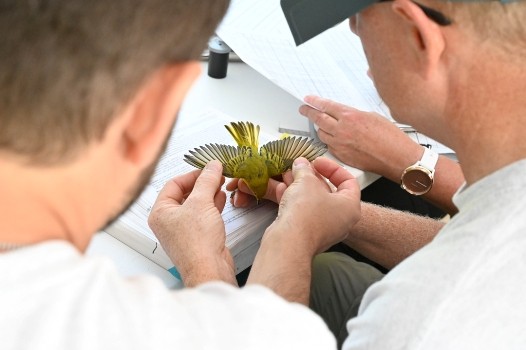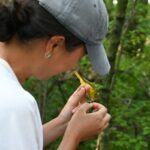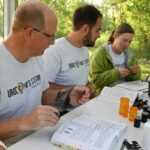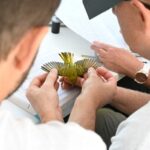Local efforts are part of a much wider effort in assisting with the conservation of birds and their habitats through demographic monitoring. The Monitoring Avian Productivity and Survival Program (MAPS) is a network of stations that capture, band, and re-capture breeding birds at over 1200 locations in North America.
The MAPS station is located at the Red River Valley Natural History Area near the University of Minnesota Crookston (UMC). Professor John Loegering, Natural Resources Department chair at UMC, and Lisa Loegering, Northwest Regional Director with UMN Extension attend the banding station. Working alongside the Loegerings are Laura Bell, lab services coordinator in natural resources at UMC and Jeff Bell, a biology instructor at Northland Community and Technical College and adjunct assistant professor at the University of North Dakota. Together, they band birds 7 times during the summer at approximately 10-day intervals.
All MAPS Stations use standardized techniques, protocols, and reporting. Data are compiled and analyzed for hundreds of bird species from across North America. The goal is to better understand reproductive productivity and survival, and the Institute for Bird Populations coordinates this extensive effort.
Using ten very fine mist nets, the Loegerings and Bells capture birds beginning at sunrise and continue for the next six hours. They have been running the station since 2012 and have logged over 1,800 captures including both initial captures and re-captures, of 54 species.
Years of training and apprenticeship are required to open a MAPS banding station and between the Loegerings and Bells, they have more than 72 years of experience banding and handling birds.
Interested students, seasonal student employees, and guests are trained to assist in the process. Natural resources major Eli Humphrey, a sophomore from Brooklyn Park, Minn., and Kimie Shiozawa, a junior from Tokyo, Japan, assisted with this summer’s operation.
The public is welcome to observe the banding process. Contact John Loegering, jloegeri@umn.edu, for dates and directions.
Tags:







